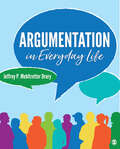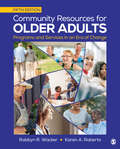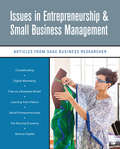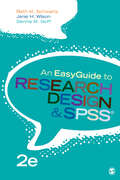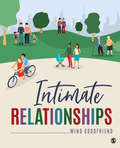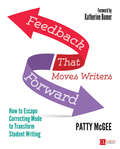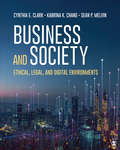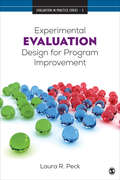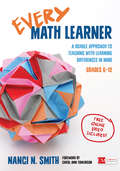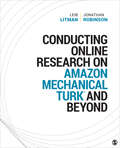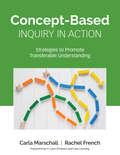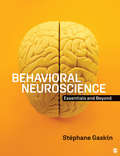- Table View
- List View
Argumentation in Everyday Life
by Jeffrey P. Drury"Good coverage of concepts with understandable explanations of theory. Very user friendly with exercises to use in and out of class. Connects well with other communication classes through the application of other communication concepts to argumentation." —Christopher Leland, Azusa Pacific University Argumentation in Everyday Life provides students with the tools they need to argue effectively in the classroom and beyond. Jeffrey P. Mehltretter Drury offers rich coverage of theory while balancing everyday applicability, allowing students to use their skills soundly. Drury introduces the fundamentals of constructing and refuting arguments using the Toulmin model and ARG conditions (Acceptability, Relevance, and Grounds). Numerous real-world examples are connected to the theories of rhetoric and argumentation discussed—enabling students to practice and apply the content in personal, civic, and professional contexts, as well as traditional academic debates. Encouraging self-reflection, this book empowers students to find their voice and create positive change through argumentation in everyday life. Unique resources to help students navigate this complex terrain of argumentation: "The Debate Situation" offers students a birds-eye view of any given debate (or exchange of arguments between two or more people) organized around three necessary components: arguments, issues, and the proposition. The visual model of the debate situation illustrates how these features work together in guiding a debate and it lays the groundwork for understanding and generating arguments. Easy to Use Standards for Evaluating Arguments combine a prominent argument model (named after logician Stephen Toulmin) with a standards-based approach (the ARG conditions) to test of quality of an argument. The ARG conditions are three questions an advocate should ask of an argument in determining whether or not it is rationally persuasive. These questions are best served by research but don’t necessary require it, and thus they provide a useful posture for critically assessing the arguments you encounter. Multiple "Everyday Life" examples with an emphasis on context help students to connect the lessons more fully to their everyday life and encourages them to grapple explicitly with dilemmas arising in different contexts. "Find Your Voice Prompts" focus on choice & empowerment to offer strategies for students to choose which arguments to address and how to address them—empowering students to use argumentation to find their voice. "Build Your Skill Prompts" use objective applications to test how well students have learned the information. They offer a chance to apply the material to additional examples that students can check against the answers in Appendix II. Two application exercises at the end of each chapter encourage students to think critically about the content, discuss their thoughts with their peers, and apply the material to everyday situations.
Community Resources for Older Adults: Programs and Services in an Era of Change
by Karen A. Roberto Robbyn R. WackerCommunity Resources for Older Adults provides comprehensive, up-to-date information on programs, services, and policies pertaining to older adults. Authors Robbyn R. Wacker and Karen A. Roberto build reader awareness of programs and discuss how to better understand help-seeking behavior, as well as explain ways to take advantage of the resources available to older adults. The substantially revised Fifth Edition includes new topics and updated research, tables, and figures to help answer key questions about the evolution and utilization of programs for older adults and the challenges that service providers face.
Community Resources for Older Adults: Programs and Services in an Era of Change
by Karen A. Roberto Robbyn R. WackerCommunity Resources for Older Adults provides comprehensive, up-to-date information on programs, services, and policies pertaining to older adults. Authors Robbyn R. Wacker and Karen A. Roberto build reader awareness of programs and discuss how to better understand help-seeking behavior, as well as explain ways to take advantage of the resources available to older adults. The substantially revised Fifth Edition includes new topics and updated research, tables, and figures to help answer key questions about the evolution and utilization of programs for older adults and the challenges that service providers face.
Issues in Entrepreneurship & Small Business Management: Articles from SAGE Business Researcher
by SAGE Business ResearcherHow different is the sharing economy from the traditional economy? What can entrepreneurs learn from failure? Can start-ups change the world? SAGE Business Researcher’s Issues in Entrepreneurship offers an in-depth and nuanced look at a wide range of today’s latest issues and controversies in entrepreneurship. This new collection of timely readings delves into current topics such as learning from failure, social entrepreneurship, flat management, crowdfunding, and more. Written with the rigor and immediacy of the best explanatory journalism, each issue provides deep, balanced, and authoritative coverage on the selected topic and key research, pointing students to reliable resources for further inquiry. These articles are perfect for outside reading assignments or in-class debates for any introductory entrepreneurship course.
Issues in Entrepreneurship & Small Business Management: Articles from SAGE Business Researcher
by SAGE Business ResearcherHow different is the sharing economy from the traditional economy? What can entrepreneurs learn from failure? Can start-ups change the world? SAGE Business Researcher’s Issues in Entrepreneurship offers an in-depth and nuanced look at a wide range of today’s latest issues and controversies in entrepreneurship. This new collection of timely readings delves into current topics such as learning from failure, social entrepreneurship, flat management, crowdfunding, and more. Written with the rigor and immediacy of the best explanatory journalism, each issue provides deep, balanced, and authoritative coverage on the selected topic and key research, pointing students to reliable resources for further inquiry. These articles are perfect for outside reading assignments or in-class debates for any introductory entrepreneurship course.
An EasyGuide to Research Design & SPSS (EasyGuide Series)
by Janie H. Wilson Beth M. Schwartz Dennis M. GoffAn EasyGuide to Research Design and SPSS® is an essential resource for students to successfully navigate and complete research projects. Using a clear, concise, and conversational writing style, authors Beth M. Schwartz, Janie H. Wilson, and Dennis M. Goff cover all of the most basic and common designs and analyses that students need to know for appropriately testing a hypothesis. The handbook includes step-by-step instructions accompanied by ample screenshots for working with data in SPSS®, along with guidance on interpreting outputs and formatting results in APA style. The Second Edition features a streamlined organization, updated references, and new content on factorial designs, effect size, and G*Power.
An EasyGuide to Research Design & SPSS (EasyGuide Series)
by Janie H. Wilson Beth M. Schwartz Dennis M. GoffAn EasyGuide to Research Design and SPSS® is an essential resource for students to successfully navigate and complete research projects. Using a clear, concise, and conversational writing style, authors Beth M. Schwartz, Janie H. Wilson, and Dennis M. Goff cover all of the most basic and common designs and analyses that students need to know for appropriately testing a hypothesis. The handbook includes step-by-step instructions accompanied by ample screenshots for working with data in SPSS®, along with guidance on interpreting outputs and formatting results in APA style. The Second Edition features a streamlined organization, updated references, and new content on factorial designs, effect size, and G*Power.
Intimate Relationships
by Wind GoodfriendRecipient of a 2021 Most Promising New Textbook Award from the Textbook & Academic Authors Association (TAA) Intimate Relationships provides students with a comprehensive understanding of the science behind relationships using a modern approach. Award-winning teacher and author Wind Goodfriend integrates coverage of family and friendship relationships in context with research methods, open science, theories, and romantic relationships so that readers can learn about all types of relationships and their interactions, including conflict and the dark side of relationships. The text supports today′s students by frequently applying relationship theories to examples that can be found in popular culture, helping students see how psychology can apply to the world that surrounds them. Included with this title: The password-protected Instructor Resource Site (formally known as SAGE Edge) offers access to all text-specific resources, including a test bank and editable, chapter-specific PowerPoint® slides.
Intimate Relationships
by Wind GoodfriendRecipient of a 2021 Most Promising New Textbook Award from the Textbook & Academic Authors Association (TAA) Intimate Relationships provides students with a comprehensive understanding of the science behind relationships using a modern approach. Award-winning teacher and author Wind Goodfriend integrates coverage of family and friendship relationships in context with research methods, open science, theories, and romantic relationships so that readers can learn about all types of relationships and their interactions, including conflict and the dark side of relationships. The text supports today′s students by frequently applying relationship theories to examples that can be found in popular culture, helping students see how psychology can apply to the world that surrounds them. Included with this title: The password-protected Instructor Resource Site (formally known as SAGE Edge) offers access to all text-specific resources, including a test bank and editable, chapter-specific PowerPoint® slides.
Feedback That Moves Writers Forward: How to Escape Correcting Mode to Transform Student Writing (Corwin Literacy)
by Patty McGee"Patty McGee should be called the ′Writer Whisperer.′ She offers brilliant advice for helping struggling writers, accomplished writers, and all those in between." —Debbie Silver, Co-author of Teaching Kids to Thrive The number one challenge of student writers today isn’t word choice, logic, voice, or even grammar and spelling—it’s buy-in. In Feedback That Moves Writers Forward, Patty McGee shares how to’s for teaching that changes the writing-as-obligation vibe for good. She demonstrates the way feedback can inspire students to reach new heights as writers. With Patty’s help, you learn to: Resign from your position as Corrector-in-Chief and be amazed as students eagerly take over responsibility for refining their writing Apply the research on growth mindset and goal setting, whether you use a writing program or a workshop model Use tone, trust, and language to quicken students’ discovery of their writing identities and take risks when they are stuck Use student work to deliver clear, just-in-time feedback during planning, drafting, revising, and editing Use the online printable forms for delivering customized feedback with just the right wording Balance grading and feedback Help writers reflect so they are better able to apply what they learned about content, craft, and style to their future writing One of the bravest things we can do as teachers is to admit when a long held practice isn’t working. Error-focused feedback is one such practice. So put down the red pen, pick up this book, and learn to say the right thing at the right time to develop fearless, original, and intentional writers—in any content area.
Feedback That Moves Writers Forward: How to Escape Correcting Mode to Transform Student Writing (Corwin Literacy)
by Patty McGee"Patty McGee should be called the ′Writer Whisperer.′ She offers brilliant advice for helping struggling writers, accomplished writers, and all those in between." —Debbie Silver, Co-author of Teaching Kids to Thrive The number one challenge of student writers today isn’t word choice, logic, voice, or even grammar and spelling—it’s buy-in. In Feedback That Moves Writers Forward, Patty McGee shares how to’s for teaching that changes the writing-as-obligation vibe for good. She demonstrates the way feedback can inspire students to reach new heights as writers. With Patty’s help, you learn to: Resign from your position as Corrector-in-Chief and be amazed as students eagerly take over responsibility for refining their writing Apply the research on growth mindset and goal setting, whether you use a writing program or a workshop model Use tone, trust, and language to quicken students’ discovery of their writing identities and take risks when they are stuck Use student work to deliver clear, just-in-time feedback during planning, drafting, revising, and editing Use the online printable forms for delivering customized feedback with just the right wording Balance grading and feedback Help writers reflect so they are better able to apply what they learned about content, craft, and style to their future writing One of the bravest things we can do as teachers is to admit when a long held practice isn’t working. Error-focused feedback is one such practice. So put down the red pen, pick up this book, and learn to say the right thing at the right time to develop fearless, original, and intentional writers—in any content area.
Bright Ribbons: Weaving Culturally Responsive Teaching Into the Elementary Classroom
by Lotus Linton HowardWeave culturally responsive teaching into every lesson and activity Culturally responsive teaching practices are like bright ribbons: when you weave them into everything you teach, you create a beautiful tapestry for successful learning. Lotus Howard, who has spent four decades teaching in diverse classrooms, will show you how to build relationships with your students and create a harmonious community where every child can thrive. You’ll learn: How to use culturally responsive teaching (CRT) not as an add-on, but as a philosophy that infuses every aspect of the school day Simple strategies for weaving the seven principles of CRT into all lessons and activities, including morning greetings, transition times, and group work How to be more self-reflective to better appreciate and unlock students’ unique gifts With an array of practical tips, model lessons, and resources, this book will inspire you to weave a holistic tapestry of teaching and learning that benefits all children.
Bright Ribbons: Weaving Culturally Responsive Teaching Into the Elementary Classroom
by Lotus Linton HowardWeave culturally responsive teaching into every lesson and activity Culturally responsive teaching practices are like bright ribbons: when you weave them into everything you teach, you create a beautiful tapestry for successful learning. Lotus Howard, who has spent four decades teaching in diverse classrooms, will show you how to build relationships with your students and create a harmonious community where every child can thrive. You’ll learn: How to use culturally responsive teaching (CRT) not as an add-on, but as a philosophy that infuses every aspect of the school day Simple strategies for weaving the seven principles of CRT into all lessons and activities, including morning greetings, transition times, and group work How to be more self-reflective to better appreciate and unlock students’ unique gifts With an array of practical tips, model lessons, and resources, this book will inspire you to weave a holistic tapestry of teaching and learning that benefits all children.
Business and Society: Ethical, Legal, and Digital Environments
by Sean P. Melvin Cynthia E. Clark Kabrina K. ChangRecipient of a 2021 Most Promising New Textbook Award from the Textbook & Academic Authors Association (TAA) Business and Society: Ethical, Legal, and Digital Environments prepares students for the modern workplace by exploring the opportunities and challenges they will face in today′s interconnected, global economy. The author team discusses legal and ethical issues throughout and uses real-world cases to provide students with a holistic understanding of stakeholder issues. Chapters on social media and citizen movements, big data and hacking, and privacy in the digital age provide in-depth coverage of how technology is transforming the relationship between organizations and consumers. Included with this title: The password-protected Instructor Resource Site (formally known as SAGE Edge) offers access to all text-specific resources, including a test bank and editable, chapter-specific PowerPoint® slides.
Business and Society: Ethical, Legal, and Digital Environments
by Sean P. Melvin Cynthia E. Clark Kabrina K. ChangRecipient of a 2021 Most Promising New Textbook Award from the Textbook & Academic Authors Association (TAA) Business and Society: Ethical, Legal, and Digital Environments prepares students for the modern workplace by exploring the opportunities and challenges they will face in today′s interconnected, global economy. The author team discusses legal and ethical issues throughout and uses real-world cases to provide students with a holistic understanding of stakeholder issues. Chapters on social media and citizen movements, big data and hacking, and privacy in the digital age provide in-depth coverage of how technology is transforming the relationship between organizations and consumers. Included with this title: The password-protected Instructor Resource Site (formally known as SAGE Edge) offers access to all text-specific resources, including a test bank and editable, chapter-specific PowerPoint® slides.
Experimental Evaluation Design for Program Improvement (Evaluation in Practice Series #5)
by Laura R. PeckThe concepts of cause and effect are critical to the field of program evaluation. Experimentally-designed evaluations—those that randomize to treatment and control groups—offer a convincing means for establishing a causal connection between a program and its effects. Experimental Evaluation Design for Program Improvement considers a range of impact evaluation questions, particularly those questions that focus on the impact of specific aspects of a program. Laura R. Peck shows how a variety of experimental evaluation design options can provide answers to these questions, and she suggests opportunities for experiments to be applied in more varied settings and focused on program improvement efforts.
Experimental Evaluation Design for Program Improvement (Evaluation in Practice Series #5)
by Laura R. PeckThe concepts of cause and effect are critical to the field of program evaluation. Experimentally-designed evaluations—those that randomize to treatment and control groups—offer a convincing means for establishing a causal connection between a program and its effects. Experimental Evaluation Design for Program Improvement considers a range of impact evaluation questions, particularly those questions that focus on the impact of specific aspects of a program. Laura R. Peck shows how a variety of experimental evaluation design options can provide answers to these questions, and she suggests opportunities for experiments to be applied in more varied settings and focused on program improvement efforts.
Every Math Learner, Grades 6-12: A Doable Approach to Teaching With Learning Differences in Mind (Corwin Mathematics Series)
by Nanci N. SmithAs a secondary mathematics teacher, you know that students are different and learn differently. And yet, when students enter your classroom, you somehow must teach these unique individuals deep mathematics content using rigorous standards. The curriculum is vast and the stakes are high. Is differentiation really the answer? How can you make it work? Nationally recognized math differentiation expert Nanci Smith debunks the myths, revealing what differentiation is and isn’t. In this engaging book Smith reveals a practical approach to teaching for real learning differences. You’ll gain insights into an achievable, daily differentiation process for ALL students. Theory-lite and practice-heavy, this book shows how to maintain order and sanity while helping your students know, understand, and even enjoy doing mathematics. Classroom videos, teacher vignettes, ready-to-go lesson ideas and rich mathematics examples help you build a manageable framework of engaging, sense-making math. Busy secondary mathematics teachers, coaches, and teacher teams will learn to Provide practical structures for assessing how each of your students learns and processes mathematics concepts Design, implement, manage, and formatively assess and respond to learning in a differentiated classroom Plan specific, standards-aligned differentiated lessons, activities, and assessments Adjust current instructional materials and program resources to better meet students′ needs This book includes classroom videos, in-depth student work samples, student surveys, templates, before-and-after lesson demonstrations, examples of 5-day sequenced lessons, and a robust companion website with downloadables of all the tools in the books plus other resources for further planning. Every Math Learner, Grades 6-12 will help you know and understand your students as learners for daily differentiation that accelerates their mathematics comprehension. "This book is an excellent resource for teachers and administrators alike. It clearly explains key tenants of effective differentiation and through an interactive approach offers numerous practical examples of secondary mathematics differentiation. This book is a must read for any educator looking to reach all students." —Brad Weinhold, Ed.D., Assistant Principal, Overland High School
Every Math Learner, Grades 6-12: A Doable Approach to Teaching With Learning Differences in Mind (Corwin Mathematics Series)
by Nanci N. SmithAs a secondary mathematics teacher, you know that students are different and learn differently. And yet, when students enter your classroom, you somehow must teach these unique individuals deep mathematics content using rigorous standards. The curriculum is vast and the stakes are high. Is differentiation really the answer? How can you make it work? Nationally recognized math differentiation expert Nanci Smith debunks the myths, revealing what differentiation is and isn’t. In this engaging book Smith reveals a practical approach to teaching for real learning differences. You’ll gain insights into an achievable, daily differentiation process for ALL students. Theory-lite and practice-heavy, this book shows how to maintain order and sanity while helping your students know, understand, and even enjoy doing mathematics. Classroom videos, teacher vignettes, ready-to-go lesson ideas and rich mathematics examples help you build a manageable framework of engaging, sense-making math. Busy secondary mathematics teachers, coaches, and teacher teams will learn to Provide practical structures for assessing how each of your students learns and processes mathematics concepts Design, implement, manage, and formatively assess and respond to learning in a differentiated classroom Plan specific, standards-aligned differentiated lessons, activities, and assessments Adjust current instructional materials and program resources to better meet students′ needs This book includes classroom videos, in-depth student work samples, student surveys, templates, before-and-after lesson demonstrations, examples of 5-day sequenced lessons, and a robust companion website with downloadables of all the tools in the books plus other resources for further planning. Every Math Learner, Grades 6-12 will help you know and understand your students as learners for daily differentiation that accelerates their mathematics comprehension. "This book is an excellent resource for teachers and administrators alike. It clearly explains key tenants of effective differentiation and through an interactive approach offers numerous practical examples of secondary mathematics differentiation. This book is a must read for any educator looking to reach all students." —Brad Weinhold, Ed.D., Assistant Principal, Overland High School
Conducting Online Research on Amazon Mechanical Turk and Beyond (SAGE Innovations in Research Methods #1)
by Jonathan Robinson Leib LitmanConducting Online Research on Amazon Mechanical Turk® and Beyond, written by Leib Litman and Jonathan Robinson, provides both students and experienced researchers with essential information about the online platforms most often used for social science research. This insightful and accessible text answers common questions like, "How do I maintain data quality in online studies?," "What is the best way to recruit hard-to-reach samples?" and "How can researchers navigate the ethical issues that are unique to online research?" Drawing on their experiences as the founders of CloudResearch (formerly TurkPrime), the authors provide information that guides new users planning their first online studies and engages even the most experienced researchers with detailed discussions about the challenges of online research. The book begins with an overview of Amazon’s Mechanical Turk and its rapid rise within academic research. Then, the authors describe how to set up an MTurk study with screenshots that walk readers through the steps of creating an account, designing a study, collecting data, and using third-party applications to enhance MTurk’s functionality. Later chapters provide readers with a detailed understanding of the MTurk environment and use data from hundreds of thousands of participants and tens of millions of completed tasks to dive into issues like participant demographics, sources of sampling bias, and the generalizability of findings from MTurk. Finally, the book explores the benefits of using other online platforms as a complement to MTurk and the ethical issues that are unique to conducting research with online participant platforms. Throughout the book, the authors share hands-on advice and best practices, such as those for conducting longitudinal studies or carrying out complex studies. Altogether the mix of data, insight, and advice make this book an essential resource for researchers who want to understand the online environment and the most effective ways to conduct research online.
Conducting Online Research on Amazon Mechanical Turk and Beyond (SAGE Innovations in Research Methods #1)
by Jonathan Robinson Leib LitmanConducting Online Research on Amazon Mechanical Turk® and Beyond, written by Leib Litman and Jonathan Robinson, provides both students and experienced researchers with essential information about the online platforms most often used for social science research. This insightful and accessible text answers common questions like, "How do I maintain data quality in online studies?," "What is the best way to recruit hard-to-reach samples?" and "How can researchers navigate the ethical issues that are unique to online research?" Drawing on their experiences as the founders of CloudResearch (formerly TurkPrime), the authors provide information that guides new users planning their first online studies and engages even the most experienced researchers with detailed discussions about the challenges of online research. The book begins with an overview of Amazon’s Mechanical Turk and its rapid rise within academic research. Then, the authors describe how to set up an MTurk study with screenshots that walk readers through the steps of creating an account, designing a study, collecting data, and using third-party applications to enhance MTurk’s functionality. Later chapters provide readers with a detailed understanding of the MTurk environment and use data from hundreds of thousands of participants and tens of millions of completed tasks to dive into issues like participant demographics, sources of sampling bias, and the generalizability of findings from MTurk. Finally, the book explores the benefits of using other online platforms as a complement to MTurk and the ethical issues that are unique to conducting research with online participant platforms. Throughout the book, the authors share hands-on advice and best practices, such as those for conducting longitudinal studies or carrying out complex studies. Altogether the mix of data, insight, and advice make this book an essential resource for researchers who want to understand the online environment and the most effective ways to conduct research online.
Concept-Based Inquiry in Action: Strategies to Promote Transferable Understanding (Corwin Teaching Essentials)
by Rachel French Carla Marschall"This is exactly what my school needs right now to support colleagues to build on the foundations of our written concept-based curriculum and to take-off our taught curriculum to the next - and highest - levels." Neville Kirton, Deputy Head of Secondary Colegio Anglo Colombiano, Bogota, Colombia "Filled with strategies, illustrations, diagrams, and pictures, this book really gives you the insight you need to help students better understand what they are learning. So many great ideas that can be used in any classroom. A must read for all educators." Amanda McKee, 9th, Algebra/Geometry, Secondary Certified Instructor/Mentor Johnsonville High School, Johnsonville, SC Create a thinking classroom that helps students move from the factual to the conceptual All students deserve the opportunity to think conceptually. But seeing conceptual relationships does not come naturally to every student. How can teachers construct thinking classrooms where students can move from the factual to the conceptual level of thinking? Concept-Based Inquiry in Action has the answers. In this book, the authors marry theory with practice to create a new framework for inquiry that promotes deep understanding: Concept-Based Inquiry. The key is helping students to inquire into concepts and the relationships between them using guiding questions developed by the teacher, the students themselves, or by the teacher and students together. Step by step, the authors lead both new and experienced educators to implement teaching strategies that support the realization of inquiry-based learning for understanding in any K–12 classroom. The book and its accompanying website are rich with the resources necessary to facilitate the construction and transfer of conceptual understanding, including Numerous practical teaching strategies, aligned to each phase of Concept-Based Inquiry, that can be modified for diverse populations Visual notes that represent significant ideas discussed within each chapter Videos of instructional strategies and teacher interviews that show Concept-Based Inquiry in action in K–12 classrooms around the world Templates of graphic organizers, sample anchor charts, and blackline masters that support the use of teaching strategies in the classroom Planners that show how the phases of Concept-Based Inquiry come together in a unit In a world filled with complexity, the role of the teacher as a facilitator of conceptual understanding has never been more pressing. Concept-Based Inquiry in Action provides teachers with the tools necessary to organize and focus student learning around concepts and conceptual relationships that support deep understanding.
Concept-Based Inquiry in Action: Strategies to Promote Transferable Understanding (Corwin Teaching Essentials)
by Rachel French Carla Marschall"This is exactly what my school needs right now to support colleagues to build on the foundations of our written concept-based curriculum and to take-off our taught curriculum to the next - and highest - levels." Neville Kirton, Deputy Head of Secondary Colegio Anglo Colombiano, Bogota, Colombia "Filled with strategies, illustrations, diagrams, and pictures, this book really gives you the insight you need to help students better understand what they are learning. So many great ideas that can be used in any classroom. A must read for all educators." Amanda McKee, 9th, Algebra/Geometry, Secondary Certified Instructor/Mentor Johnsonville High School, Johnsonville, SC Create a thinking classroom that helps students move from the factual to the conceptual All students deserve the opportunity to think conceptually. But seeing conceptual relationships does not come naturally to every student. How can teachers construct thinking classrooms where students can move from the factual to the conceptual level of thinking? Concept-Based Inquiry in Action has the answers. In this book, the authors marry theory with practice to create a new framework for inquiry that promotes deep understanding: Concept-Based Inquiry. The key is helping students to inquire into concepts and the relationships between them using guiding questions developed by the teacher, the students themselves, or by the teacher and students together. Step by step, the authors lead both new and experienced educators to implement teaching strategies that support the realization of inquiry-based learning for understanding in any K–12 classroom. The book and its accompanying website are rich with the resources necessary to facilitate the construction and transfer of conceptual understanding, including Numerous practical teaching strategies, aligned to each phase of Concept-Based Inquiry, that can be modified for diverse populations Visual notes that represent significant ideas discussed within each chapter Videos of instructional strategies and teacher interviews that show Concept-Based Inquiry in action in K–12 classrooms around the world Templates of graphic organizers, sample anchor charts, and blackline masters that support the use of teaching strategies in the classroom Planners that show how the phases of Concept-Based Inquiry come together in a unit In a world filled with complexity, the role of the teacher as a facilitator of conceptual understanding has never been more pressing. Concept-Based Inquiry in Action provides teachers with the tools necessary to organize and focus student learning around concepts and conceptual relationships that support deep understanding.
Behavioral Neuroscience: Essentials and Beyond
by Stéphane GaskinBehavioral Neuroscience: Essentials and Beyond shows students the basics of biological psychology using a modern and research-based perspective. With fresh coverage of applied topics and complex phenomena, including social neuroscience and consciousness, author Stéphane Gaskin delivers the most current research and developments surrounding the brain′s functions through student-centered pedagogy. Carefully crafted features introduce students to challenging biological and neuroscience-based concepts through illustrations of real-life application, exploring myths and misconceptions, and addressing students′ assumptions head on.
Behavioral Neuroscience: Essentials and Beyond
by Stéphane GaskinBehavioral Neuroscience: Essentials and Beyond shows students the basics of biological psychology using a modern and research-based perspective. With fresh coverage of applied topics and complex phenomena, including social neuroscience and consciousness, author Stéphane Gaskin delivers the most current research and developments surrounding the brain′s functions through student-centered pedagogy. Carefully crafted features introduce students to challenging biological and neuroscience-based concepts through illustrations of real-life application, exploring myths and misconceptions, and addressing students′ assumptions head on.
